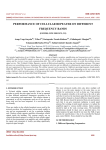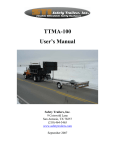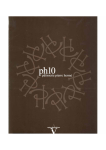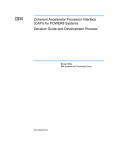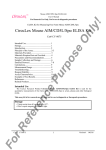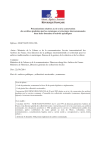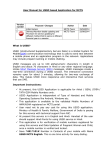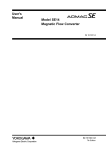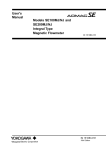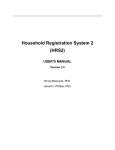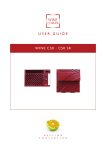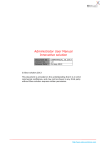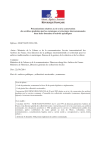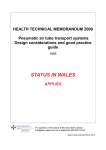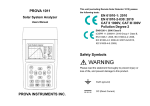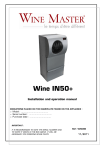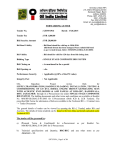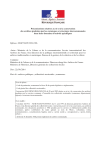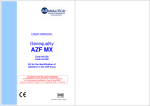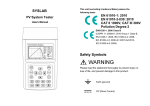Download - Immunization Technical Support Unit
Transcript
Equipment Specifications for Refrigerated Van Capacity: Vaccine storage capacity: Clau se Description Subclause 20cum Technical Particulars 1.0 Storage Capacity 1.1 Refrigerated vaccine compartment capacity: 20 cum 2.0 Applications 2.1 The refrigerated van is required to transport large quantity of vaccine from Regional vaccine stores to District vaccine store, where long distances are covered maintaining the temperature within the storage compartment as per para-3.0. 2.2 A single-phase motor compressor cooling unit, operating on 220 Volts, mounted on the driver’s cabin. 2.3 During the normal operation / running of the vehicle, the compressor shall be powered through a diesel generator. It should also have a provision to connect to external electric power source, in case of long halt at one location with vaccine load or any emergency such as diesel generator failure, or fuel shortage.. 3.1 The Refrigeration unit must maintain the interior of the insulated body / vaccine storage compartment at a temperature between + 2 deg. C to +8 deg C at any point, with full load or no load of vaccine. 3.2 The specified temperature must always be be maintained continuously, so long as any vaccine is expected to be loaded, or is in all ambient temperature conditions. 3.3 The temperature gradient should not be more than 2 deg C across any two points in vaccine compartment. 3.4 There should be provision to continuously monitor the temperature of the storage compartment. There should be a visual indicator at the 3.0 Temperature recording Clau se Description Subclause Technical Particulars dashboard for the driver to observe any temperature variation during the transport / storage of the vaccine load in the vehicle. 3.5 There should be provision to keep hard and soft copy records of the continuously monitored temperature. These records need to be maintained for a minimum of three years. 4.1 The body comprises of outer and inner panels and an insulating material. 4.2 The outer and inner panels should be of cold rolled (CR) sheet / stainless steel / Glass Reinforced plastic (GRP) or aluminium. 4.3 Inner chamber should not be connected with outer enclosure or doors through any thermally conductive material or joints. 4.4 The vaccine compartment should be reinforced appropriately to manage structural integrity and to handle 6000 kg pay load. Insulated Body 4.0 Structure 4.5 Internal ceiling-mounted low energy fluorescent or LED luminaires should be used for lighting of the vaccine compartment with an external switch with pilot light. On the dashboard 4.6 The cargo chamber should have powder coated adjustable shelves having depth of 450mm and width 750mm running along the long sides. 4.7 Provision for two shelves in the cargo chamber along the two longer side walls. 4.8 The storage rack should have mechanism for bracing the vaccines cartons to prevent any movement or drop during the movement of the vehicle. 4.9 The bottom most shelf should provide a ground clearance of 100 mm. Clau se Description Subclause Technical Particulars 4.10 The floor of the Vaccine storage compartment should be of robust structure capable of supporting the pay load and the movement on account of material handling. 4.11 There should be a camera facing the rear door and lock with screen in driver’s cabin so that the driver can keep watch on rear door during travelling. 4.12 5.0 4.13 Four drainage points should be placed close to four corners with screw type cap at outside and removable plug from inside. The caps and plugs should be so attached to prevent them from getting lost. 4.14 The body should be in the aerodynamic shape from the front. 4.15 The roof should have slightly sloped to avoid accumulation of any rain water on its top. 4.16 Corners of the Vaccine storage compartment should be smooth without sharp edges. 4.17 Outer body should be painted white to reflect Sun light Outer panel – 5.1 roof and side walls Suitable / SS / GRP Aluminium or CR sheets with quality PUF insulation to meet the pay load requirement and general wear and tear abuses. 5.2 Reinforcements / columns / sections must be used everywhere to maintain structural strength and integrity so as to support racks, ducts, fans, people movement, straps and hooks etc. 5.3 Refrigeration unit with DG Set must be supported on outer enclosure, properly reinforced, with adequate protection of the unit from natural elements. 5.4 Outer body should be totally leak-proof, to protect insulation and payload. 5.5 Refrigerator unit and DG set enclosure must have provision to drain rain water, any fuel Clau se Description Subclause Technical Particulars leakage etc. 6.0 7.0 8.0 9.0 Inner panel – 6.1 side wall and ceiling 6.2 Suitable SS/GRP Aluminium or CR sheets with minimum 6 mm marine grade ply wood on walls. Floor 7.1 Floor must be of minimum 5 mm slip proof aluminium checkered plat, fastened on 19mm solid marine grade wood. 7.2 It should rest on reinforcements filled/ covered with PUF, over strong, steel / GRP/ wooden outer base. 7.3 Shelf to shelf walking way of the floor should be covered with the perforated non-slip rubber mat of minimum 20 mm thickness. 8.1 Two leaves with outer and inner panels with thermal insulation identical to the rest of the compartment walls. 8.2 It should be completely air sealed with FRP section and suitable PVC outer/ EPDM rubber inner profile. 8.3 Both leaves should have (minimum 3). 8.4 The door design should be in such a way that it should provide complete insulation from outside. 8.5 The hinge and lock structure should lock the door at the bottom and top using latch bar cam lock. 8.6 Doors should be connected to outer enclosure, suitably reinforced with steel / GRP / Aluminium or SS sections. 9.1 Opening angle Minimum 270 o There should be adequate mechanism to block the door in its open position. Door Door opening All joints should be sealed with good quality durable sealants and fastened with SS screws adequate reinforcement of the inner walls to support air blower / duct network running along ceiling to provide uniform cooling in the cargo chamber. multiple hinges Clau se 10.0 11.0 Description Insulation Hold Over Time Subclause Technical Particulars 9.2 The opening must also be fitted internally with a clear plastic flexible strip curtain There should be a clear plastic flexible strip curtain at the extreme end of the vaccine compartment towards the door to minimise exchange / loss of refrigerated atmosphere when the door/s are opened for loading and unloading of vaccines. 10.1 The insulated material should be poly urethane foam (PUF) 10.2 Minimum foam density of 30 kg /cubic meter, with suitable wall and floor thickness 10.3 Thermal Conductivity: Maximum 0.025w/m 0K for PUF /0.6 W/m20K for cargo chamber at 10oC. 11.1 The vaccine storage compartment should hold the inside temperature below 10 deg C at least for 3 Hours at the ambient temperature of 43oC when it is not opened. 12.1 The refrigerant must comply with the Montreal Protocol. It must be CFC-free and preferably HCFC-free. It is preferable to use a refrigerant that has low or 0 GWP. 12.2 The refrigeration equipment independently diesel powered. 12.3 There should be an automatic start-up and shutdown mechanism through electronic temperature control unit as defined in 17. 13.1 The refrigeration unit is installed on the body above the drivers cabin of the vehicle. 13.2 It should have suitable sized compressor, evaporator and control switches along with voltage stabilizer to maintain the temperature as defined in 3.0 14.1 An inbuilt DG set integrated with refrigeration Refrigeration unit 12.0 13.0 14.0 Refrigeration unit Unit installation Power supply should be Clau se Description Subclause Technical Particulars system should be provided with a by-pass arrangement for the Motor. 15.0 Stand by motor 15.1 15.2 15.3 15.4 15.5 A standby electric motor should be provided to drive the compressor of the refrigeration unit and maintain the internal temperature of the compartment at the desired level for pre-cooling the vaccine storage compartment or during extended stops. A selector switch should be provided to select power option between diesel generator supply or 220 V single phase grid supply. An extension lead of 20 meters 3 core cable capable of carrying 15 amperes. (2.5 Sqmm multi strand Copper conductor each) should be provided to connect the grid supply to the electric motor. The cable connection should be of the type 20970 / 16 A. There should be adequate provision, preferably on the door of the vaccine storage chamber to roll the long electric cable in a manner to facilitate its storage ad transport when not in use. Temperature Control 16.0 Temperature Monitoring 16.1 Effective air temperature monitoring with a minimum of two fixed sensors in the vaccine storage compartment. 16.2 One sensor should be positioned below the cooling unit to measure return air temperature. 16.3 Other sensor on the ceiling about three quarters of the way down the length of the compartment. 16.4 In the case of a cooling unit, which does not use forced air, the air temperature should be measured above and below the load, to take into account the likely vertical temperature gradients. 16.5 Sensors must be connected to a suitable recording instrument, permanently mounted in the vehicle cab. 16.6 In addition to temperature recorder, the truck should be fitted with an instantaneous digital Clau se Description Subclause Technical Particulars temperature display on the driver’s dashboard. 17.0 Digital unit 16.7 It should have visual as well as acoustic alarm system. As soon as the vaccine temperature crosses the safe range alarms alerts the driver. 16.8 GSM based location tracker should also be provided with cloud based/internet browser based monitoring, using free software to ensure that maximum permitted driving periods are not exceeded. Control 17.1 A digital, programmable controller should allow auto & manual control of : 1. air humidity, 2. temperature control, 3. defrost feature. 18.0 Additional Accessories 17.2 The control unit should provide visual indication of the following : 1. Power on / off 2. Compressor on, 3. Return air temperature, 4. Supply air temperature. 5. Temperature of return air fan, 6. Defrost operations. 17.3 The diesel level of DG set fuel tank should be visible at the dash board of the driver. 18.1 A suitable size folding ladder should be provided. 18.2 Footsteps and hand grips at the back for climbing in the cargo box should be provided. 18.3 A hook for holding the cable of stand by motor at the inner side of the door should be provided. 18.4 The vehicle, doors of the refrigerated body and all fuel cap should be fitted with security deadlocks. Base Vehicle specifications 19.0 Engine 19.1 Diesel Engine 19.2 Direct Injection, Clau se Description Subclause Technical Particulars 19.3 Turbo charged 19.4 Inter-cooled. 20.0 No. of Cylinder 20.1 In Line 4/6 Cylinder 4 Stroke direct ignition 21.0 Capacity 21.1 3700 CC and above 22.0 Minimum KW/RPM 22.1 Minimum 60 KW @ 2400 rpm 23.0 Transmission 23.1 5-4 Forward, 1 Reverse with power assisted steering mechanism. 24.0 Clutch 24.1 Dry single Plate 25.0 Brakes 25.1 Full Air S-cam brake 26.0 Frame Section 26.1 Rectangular 27.0 Cooling 27.1 Water Cooled 28.0 Voltage 28.1 Suitable : 12 / 24 Volts 29.0 Battery 29.1 Suitable of reputed and easily available brand 30.0 Fuel Tank 30.1 Minimum: 150 Ltrs. 31.0 Suspension 31.1 Semi Elliptical Leaf Spring. 32.0 Shock Absorbers Telescopic 32.0 Hydraulic Double Acting Telescopic 33.0 Tyres 33.1 Radial/Nylon 34.0 Wheel Base 34.1 Minimum 3800 mm 35.0 Weight Carrying 35.1 capacity 2500 Kgs or more 36.0 Ground Clearance 36.1 Minimum 160mm under maximum load 37.0 Wheel Drive 37.1 2 Wheel Drive 38.0 Gross weight vehicle 38.1 Min. 7000 Kg. 39.0 Turning radius 39.1 Max. 9.0 meters 40.0 Emission norms 40.1 As per prevailing norms of Government of India and CPCB guidelines at the time of supply. 41.0 Standard Kit tool 41.1 Standard tool kit such as lifting jack, Wheel spanner, screw drivers etc. should be provided Clau se Description Subclause Technical Particulars with each vehicle. Testing requirement Air tightness 42.1 test of the doors 0.5 cum per hour or less Temperature Mapping Maximum difference between any 2 points of the storage compartment is less or equal to 2 deg C. The minimum should never be below 0 deg C, and the maximum should never be above 10 deg C. when the average is respectively 2 and 8 deg C. 43.0 Heat test Once stabilized, temperature should not rise above 10 deg C in 3hours at 50 deg. C. 44.0 Certificates testing 42.0 45.0 46.0 Leakage 43.1 Spare parts Workshop operating manuals: of 44.1 All above mentioned test should be conducted through an approved laboratory by the Government of India and the equipment should be supplied along with roadworthiness certificate from ARAI / other NABL bodies. 44.2 The temperature monitoring device should be supplied with a traceable certificate of calibration which must be renewed annually. 44.3 The certificate should be valid for the range of temperatures (+ 2 to +8 Deg C) that the device normally measures. 45.1 A list of in country dealer network should be provided which holds the spare parts for the vehicle as well as for refrigeration unit. 45.2 Provide a list of most commonly required spares along with cost. and 46.1 Provide the following manuals in English: 1. User’s operation manual for the refrigeration unit 2. Maintenance with trouble shooting manual for refrigeration unit 3. User’s manual for the vehicle 4. Service and repair manual for vehicle with details of periodic maintenance (Dr. Jitendra Sharma) (Manjari Sharma) (S.K.Saxena) For NHRC for MOHFW For HLL Lifecare (S. Gangadharan) (Dr. M.K. Agarwal) (Dr. S.Y. Kothari) For Dy. Director (Proc.) Dy. Commissioner (UIP) Spl. DGHS, MOHFW










